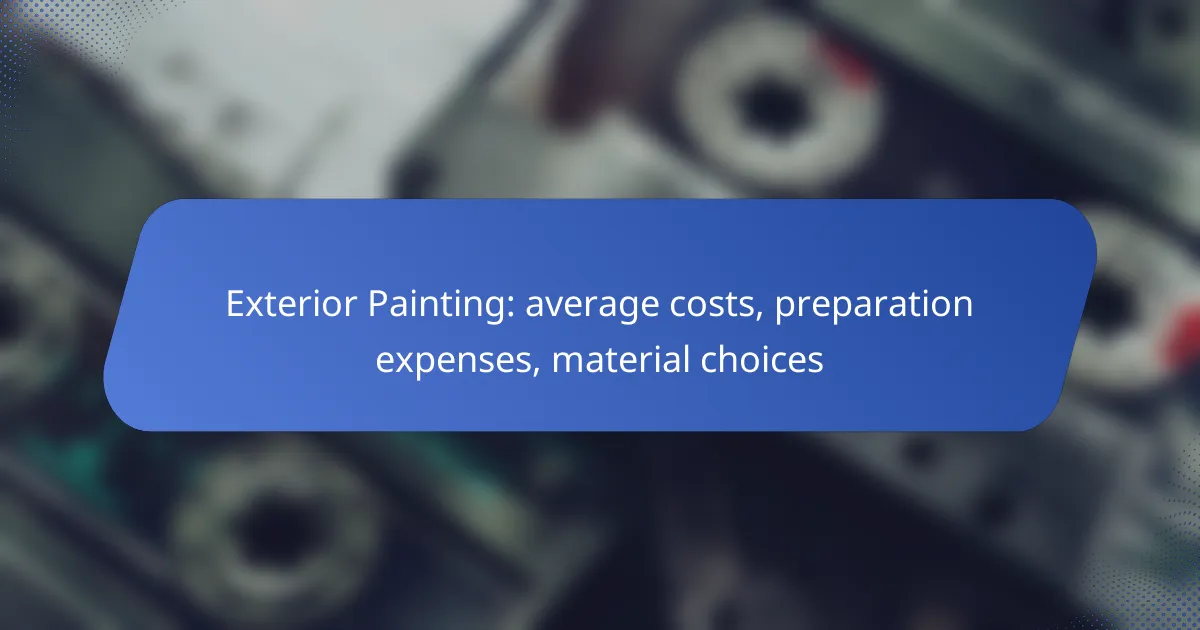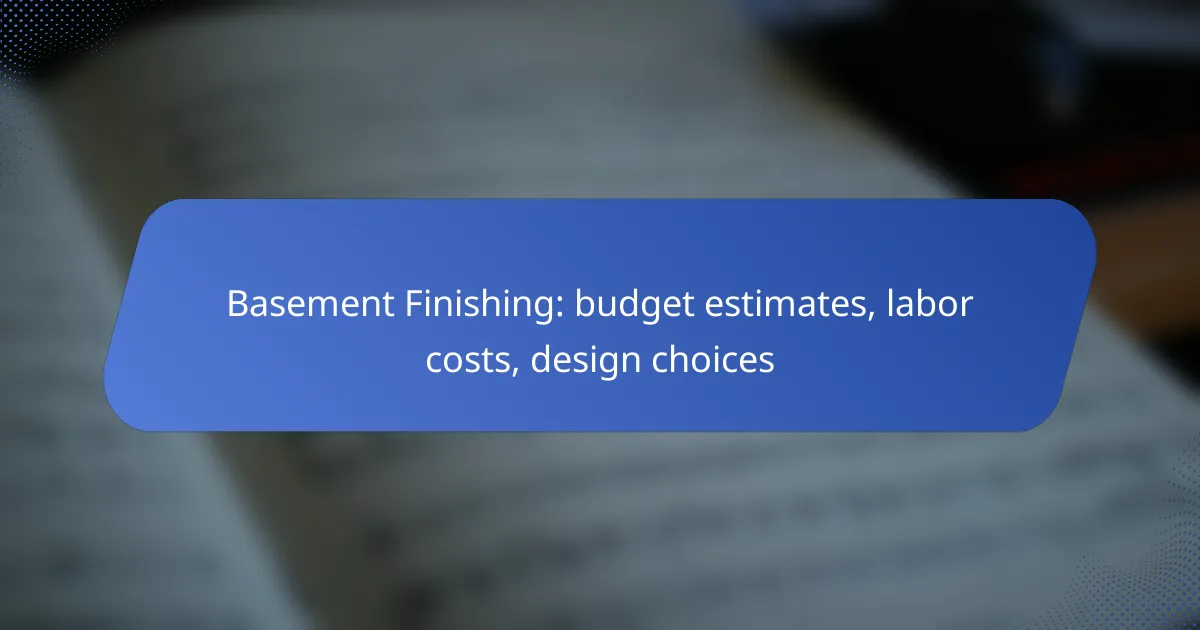Exterior painting is an essential home improvement project that can enhance curb appeal and protect your property. In the UK, average costs range from £15 to £30 per square meter, influenced by factors such as paint type and surface condition. Homeowners should also account for preparation expenses, which include cleaning, repairs, and primer application, as well as carefully selecting materials like acrylic or oil-based paints to ensure durability and aesthetic appeal.

What are the average costs of exterior painting in the UK?
The average costs of exterior painting in the UK typically range from £15 to £30 per square meter, depending on various factors such as the type of paint used and the condition of the surfaces. Homeowners should budget for both preparation and material expenses to get a complete picture of the total project cost.
Cost per square meter
The cost per square meter for exterior painting can vary significantly based on the quality of materials and the complexity of the job. Basic exterior paint jobs may start at around £15 per square meter, while high-quality finishes can reach £30 or more. It’s essential to obtain multiple quotes from contractors to ensure competitive pricing.
Average total project cost
The average total project cost for exterior painting of a standard three-bedroom house in the UK generally falls between £1,500 and £3,000. This estimate includes labor, materials, and preparation work. Larger homes or those requiring extensive repairs may see costs rise beyond this range.
Factors affecting pricing
Preparation work, such as scraping, sanding, or repairing surfaces, can also add to the overall cost. Homeowners should consider these elements when planning their budget to avoid unexpected expenses during the project.
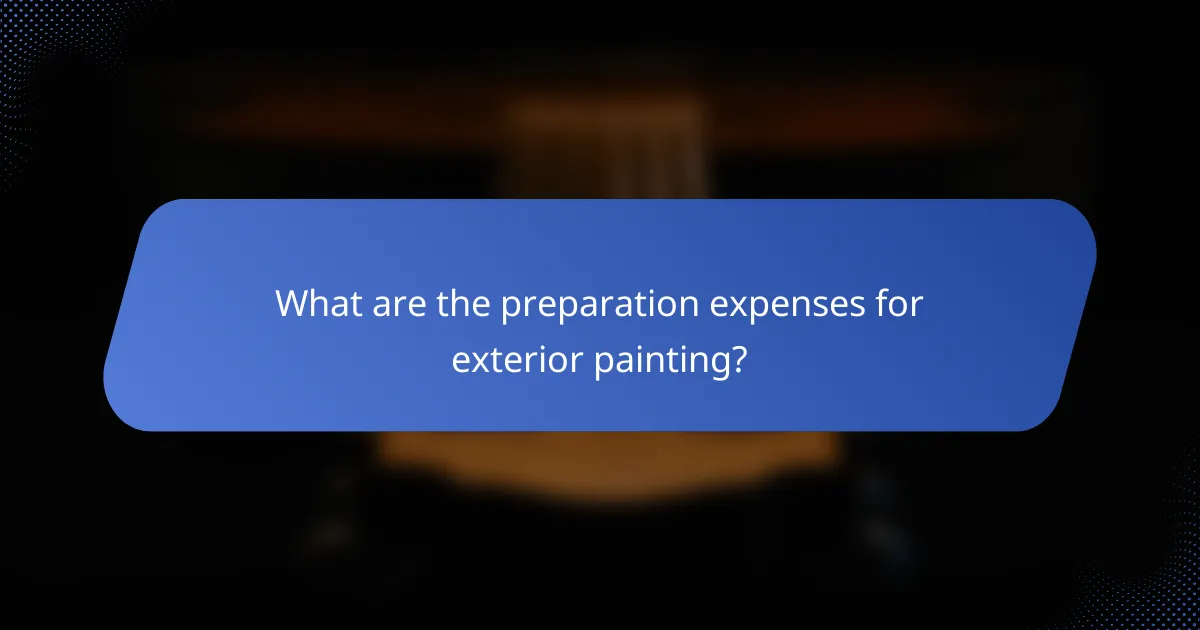
What are the preparation expenses for exterior painting?
Preparation expenses for exterior painting can significantly impact the overall cost of the project. These expenses typically include surface cleaning, repairs for damaged areas, and the application of primer and sealants.
Surface cleaning costs
Surface cleaning is essential to ensure proper paint adhesion and longevity. Costs for cleaning can vary based on the size of the area and the method used, with pressure washing typically ranging from $0.15 to $0.30 per square foot. For larger homes, this can add up to several hundred dollars.
Consider the type of surface being cleaned; wood, stucco, and brick may require different cleaning techniques and costs. Hiring professionals can ensure thorough cleaning, but DIY methods can save money if done carefully.
Repair costs for damaged surfaces
Repairing damaged surfaces is crucial before painting to avoid future issues. Common repairs include filling cracks, replacing rotting wood, or patching holes, with costs ranging from $100 to $1,000 depending on the extent of the damage. Minor repairs can often be handled by a homeowner, while extensive damage may require professional help.
Evaluate the condition of your exterior before painting; addressing repairs early can prevent more significant expenses later. Always budget for unexpected repairs that may arise during the preparation phase.
Cost of primer and sealants
The cost of primer and sealants is an important consideration in the preparation for exterior painting. Primers typically range from $15 to $30 per gallon, while sealants can cost between $10 and $25 per gallon. The total amount needed will depend on the surface area and the number of coats required.
Using a quality primer can enhance the paint’s durability and finish, making it a worthwhile investment. Always check for compatibility with your chosen paint to ensure optimal results.
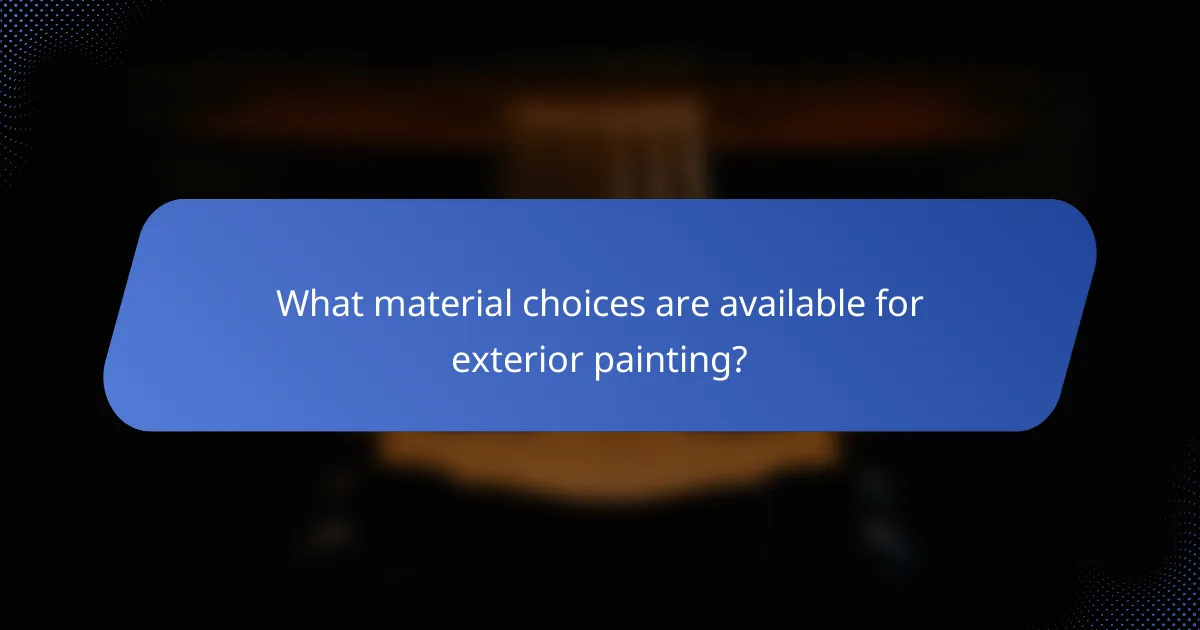
What material choices are available for exterior painting?
When selecting materials for exterior painting, homeowners typically consider acrylic, oil-based, and eco-friendly options. Each type has distinct characteristics that affect durability, appearance, and environmental impact.
Acrylic paint options
Acrylic paints are water-based and known for their quick drying times and ease of application. They offer excellent color retention and resistance to fading, making them suitable for various climates.
These paints are flexible, which helps prevent cracking and peeling over time. Prices for acrylic paints generally range from moderate to high, depending on the brand and quality.
Oil-based paint benefits
Oil-based paints provide a durable finish that is resistant to wear and tear, making them ideal for high-traffic areas or harsh weather conditions. They tend to have a smoother application and better adhesion on surfaces like wood and metal.
However, oil-based paints take longer to dry and require solvents for cleanup. They are often more expensive than acrylic options, but their longevity can justify the higher initial cost.
Eco-friendly paint alternatives
Eco-friendly paints are formulated with low or no volatile organic compounds (VOCs), making them safer for both the environment and indoor air quality. These options are increasingly popular among homeowners looking to reduce their ecological footprint.
While eco-friendly paints may have a higher upfront cost, they often provide comparable durability and finish quality. It’s essential to check for certifications like Green Seal or EcoLogo to ensure the product meets environmental standards.
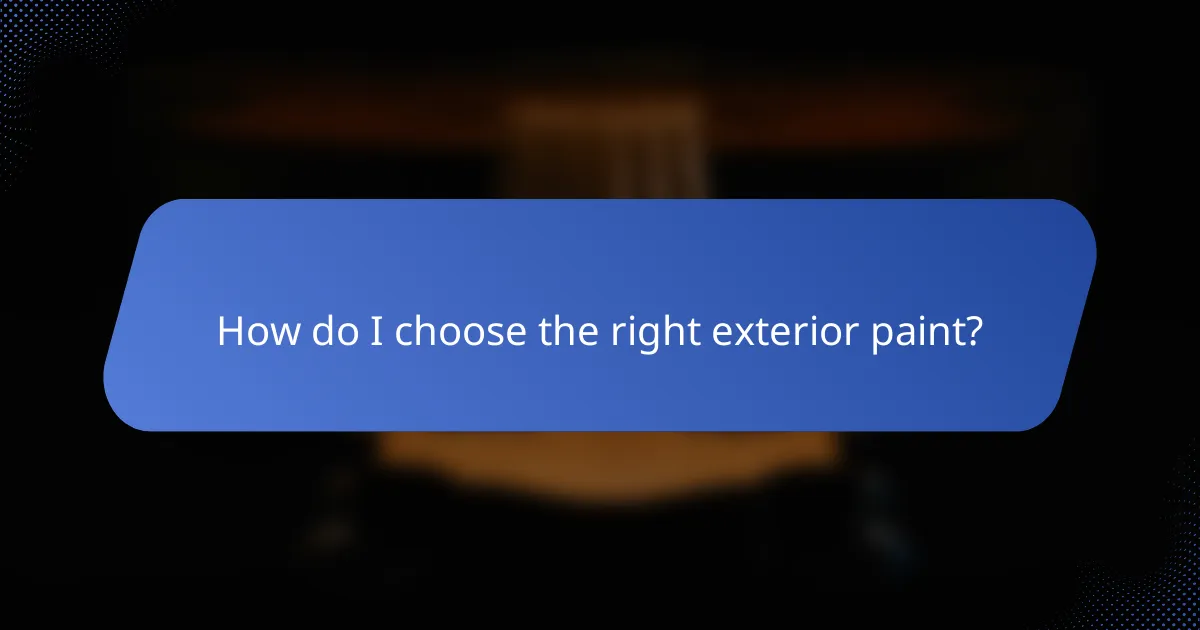
How do I choose the right exterior paint?
Choosing the right exterior paint involves considering durability, color, and finish to ensure long-lasting results. Evaluate your local climate, the material of your home, and your aesthetic preferences to make an informed decision.
Durability considerations
Durability is crucial when selecting exterior paint, as it must withstand various weather conditions. Look for paints with high resistance to fading, moisture, and mildew, especially in humid or rainy climates.
Consider materials like acrylic latex, which offers excellent durability and flexibility. For homes in extreme weather areas, a paint with a higher grade or specialized formulation may be necessary, potentially costing more but providing better protection.
Color selection tips
When selecting a color for exterior paint, consider the architectural style of your home and the surrounding environment. Neutral colors often blend well with natural landscapes, while bold colors can make a statement.
Test paint samples on your home’s exterior to see how they look in different lighting conditions throughout the day. Remember that local regulations or homeowners’ associations may have guidelines on acceptable color schemes.
Finish types explained
Exterior paint finishes range from flat to high gloss, each offering different benefits. Flat finishes hide imperfections well but may not be as durable, while semi-gloss and gloss finishes are easier to clean and more resistant to moisture.
For most homes, a satin or eggshell finish strikes a balance between durability and aesthetic appeal. Consider the specific needs of your home, such as high-traffic areas or regions with heavy rainfall, when selecting the appropriate finish type.

What are the best practices for exterior painting?
Best practices for exterior painting include proper preparation, choosing the right materials, and applying techniques suited to the environment. Following these guidelines helps ensure a long-lasting and aesthetically pleasing finish.
Weather considerations
Weather plays a crucial role in exterior painting. Ideal conditions typically involve temperatures between 10°C and 30°C, with low humidity and minimal wind. Avoid painting during rain or extreme heat, as these factors can affect the paint’s adhesion and drying time.
Check local forecasts to plan your project effectively. If rain is expected within 24 hours, it’s best to postpone the job to prevent damage to the newly applied paint.
Tools and equipment needed
Essential tools for exterior painting include brushes, rollers, and sprayers, depending on the surface area and texture. A ladder or scaffolding may be necessary for reaching higher areas safely.
Additionally, invest in drop cloths to protect surrounding areas, painter’s tape for clean edges, and a pressure washer for surface preparation. Having these tools on hand will streamline the painting process and improve results.
Application techniques
Proper application techniques can significantly impact the final appearance of your paint job. Start with a primer to ensure better adhesion, especially on porous surfaces or when changing colors dramatically.
When applying paint, use long, even strokes and work in sections to maintain a wet edge, preventing lap marks. For larger areas, a sprayer can provide a smooth finish, but be mindful of overspray and surrounding surfaces.

What are the long-term maintenance costs after exterior painting?
Long-term maintenance costs after exterior painting can vary significantly based on factors such as climate, paint quality, and the condition of the underlying surfaces. Regular upkeep, including repainting and repairs, is essential to preserve the appearance and integrity of the exterior surfaces.
Frequency of repainting
The frequency of repainting typically ranges from every 5 to 10 years, depending on the type of paint used and environmental conditions. High-quality paints may last longer, while homes in harsh climates may require more frequent attention. Regular inspections can help identify when repainting is necessary.
Consider the material of your home as well; wood siding may need more frequent repainting than brick or stucco. Keeping an eye on fading, peeling, or chipping paint can guide your repainting schedule.
Repair and touch-up costs
Repair and touch-up costs can vary, but budgeting for minor repairs every few years is wise. Common issues include cracks, peeling, and water damage, which may require patching or caulking. Depending on the extent of the damage, costs can range from a few dollars for small touch-ups to hundreds for more significant repairs.
To minimize these costs, perform regular maintenance checks and address issues promptly. This proactive approach can extend the life of your paint job and reduce the need for extensive repairs later on.






